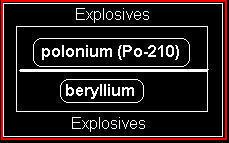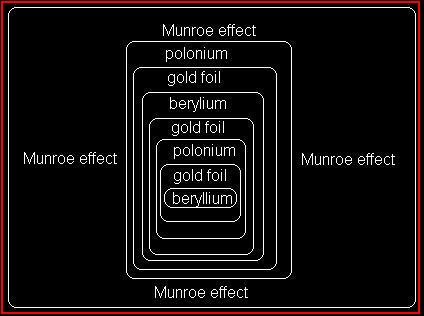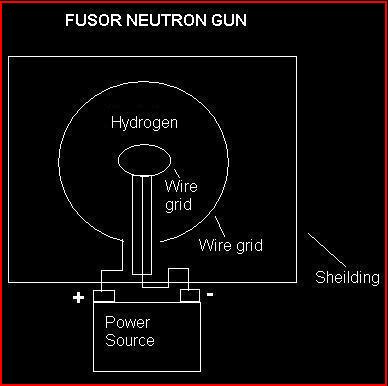
Legal Disclaimer Legal information enclosed. Please read.




Neutron trigger / initiator
One of the key elements in the proper operation of a nuclear weapon is initiation of the fission chain reaction at the proper time. To obtain a significant nuclear yield of the nuclear explosive, sufficient neutrons must be present within the supercritical core at just the right time. If the chain reaction starts too soon, the result will be only a 'fizzle yield', much below the design specification; if it occurs too late, there may be no yield whatsoever. Several ways to produce neutrons at the appropriate moment have been developed.
Early neutron triggers consisted of a highly radioactive isotope of polonium (Po-210), which is a strong alpha emitter combined with beryllium which will absorb alphas and emit neutrons. This isotope of polonium has a half life of 138 days. Therefore, a neutron initiator using this material needs to have the polonium replaced frequently. The polonium is produced in a nuclear reactor.
To supply the initiation pulse of neutrons at the right time, the polonium and the beryllium need to be kept apart until the appropriate moment and then thoroughly and rapidly mixed by the implosion of the weapon. This method of neutron initiation is sufficient for weapons utilizing the slower gun combination method, but the timing is not precise enough for an implosion weapon design. The "Fat Man" weapon of World War II used a finely tooled initiator known as an "urchin", made of alternating concentric layers of beryllium and polonium separated with thin gold foils. When these layers are mixed (by the Munroe effect), the high-energy alpha particles produced by the polonium hit beryllium nuclei, expelling neutrons to initiate the fission process.
Another method of providing source neutrons is through a pulsed neutron emitter, which is a small ion accelerator with a metal hydride target. When the ion source is turned on to create a plasma of deuterium or tritium, a large voltage is applied across the tube which accelerates the ions into tritium rich metal (usually scandium). The ions are accelerated so that there is a high probability of nuclear fusion occurring. The deuterium-tritium fusion reactions emit a short pulse of 14 MeV neutrons which will be sufficient to initiate the fission chain reaction. The timing of the pulse can be precisely controlled, making it better for an implosion weapon design.
An initiator is not strictly necessary for an effective gun design, as long as the design uses "target capture" (in essence, ensuring that the two subcritical masses, once fired together, cannot come apart until they explode). Initiators were only added to Little Boy late in its design. The use of an initiator can guarantee precise control (to the millisecond) over the timing of the explosion.
Monroe effect
The Munroe effect refers to the partial focusing of blast energy caused by a hollow or void cut into a piece of explosive, a property which is exploited by a shaped charge.
Explosive energy is released directly away from (normal to) the surface of an explosive, so shaping the explosive will concentrate the explosive energy in the void. If the void is properly shaped (usually conically), a high-velocity jet of plasma will form.
It is named after Charles E. Munroe, who discovered it in 1888. Whilst working at the Naval Torpedo Station at Newport in the United States, he noticed that when a block of guncotton with the manufacturer's name stamped into it was detonated next to a metal plate, the lettering was cut into the plate. If letters were raised in relief above the rest of the guncotton then the letters on the plate would also be raised above its surface. In 1910, Egon Neumann of Germany discovered that TNT containing a conical indentation would cut through a metal plate which would normally only be dented by that quantity of explosive. However, the military usefulness of this effect was not appreciated until the Second World War.
In modern military applications, a Munroe-effect shaped-charge warhead can be expected to penetrate solid steel armor equal to 150–250% of the warhead diameter, though it will tend to be somewhat less effective against modern composite armors and reactive armor which was developed specifically as a counter to shaped charge weapons.
In peaceful engineering applications shaped charges are valued for their versatility and speed. A few hundred pounds of well placed shaped charges can demolish a building faster than several hundred tons of machinery, and in steel manufacturing small shaped charges are often used to pierce taps that have become plugged with slag.
A device called a "Jet-Axe" was also used sometime around the 1960s or 1970s by fire brigades in the United Kingdom to cut holes through reinforced doors and walls to help gain access to fight fires or rescue people. The "Jet-Axe" was the shape of a flattened doughnut with a hole in the middle and contained a ring of a shaped charge. The device would be hung on a door or wall with the shaped charge facing the door or wall and when detonated it would cut a circular hole through it. The "Jet-Axe" was roughly 2 feet in diameter. Such a device was demonstrated on British TV in a popular programme called Tomorrow's World with Raymond Baxter.